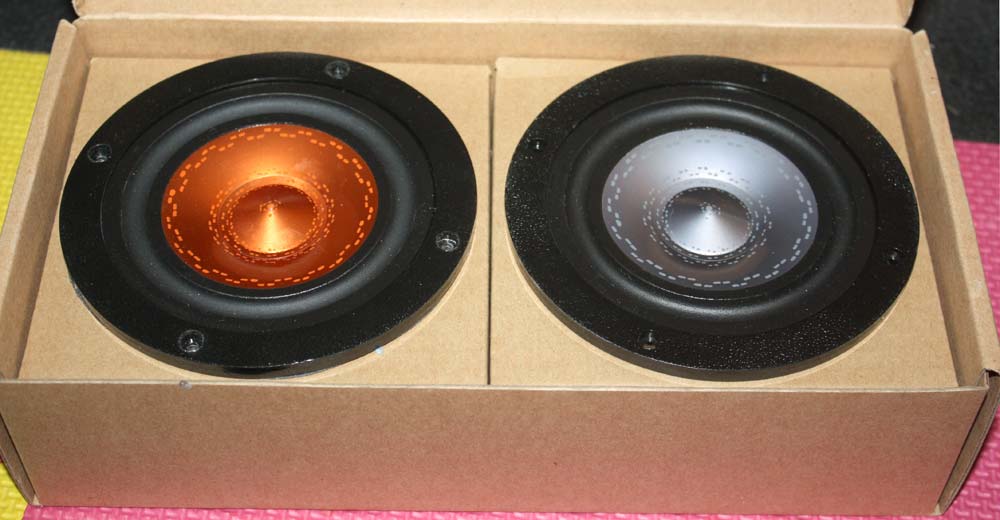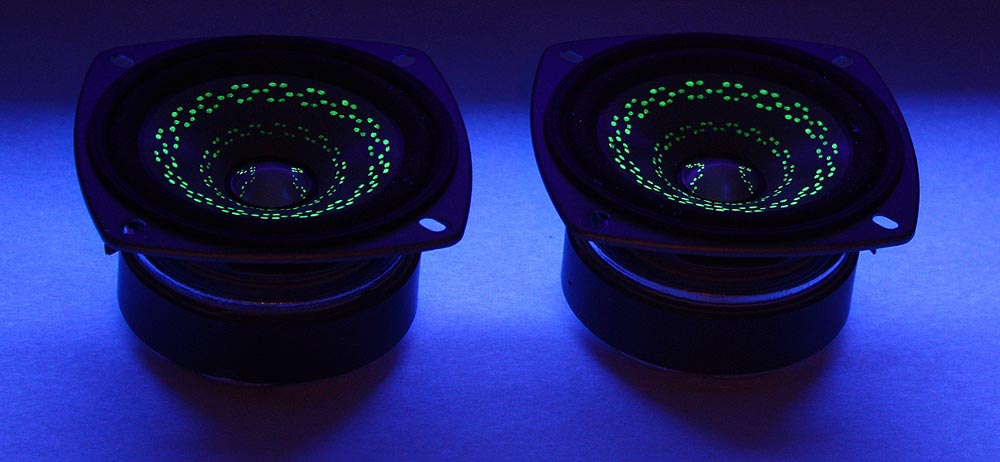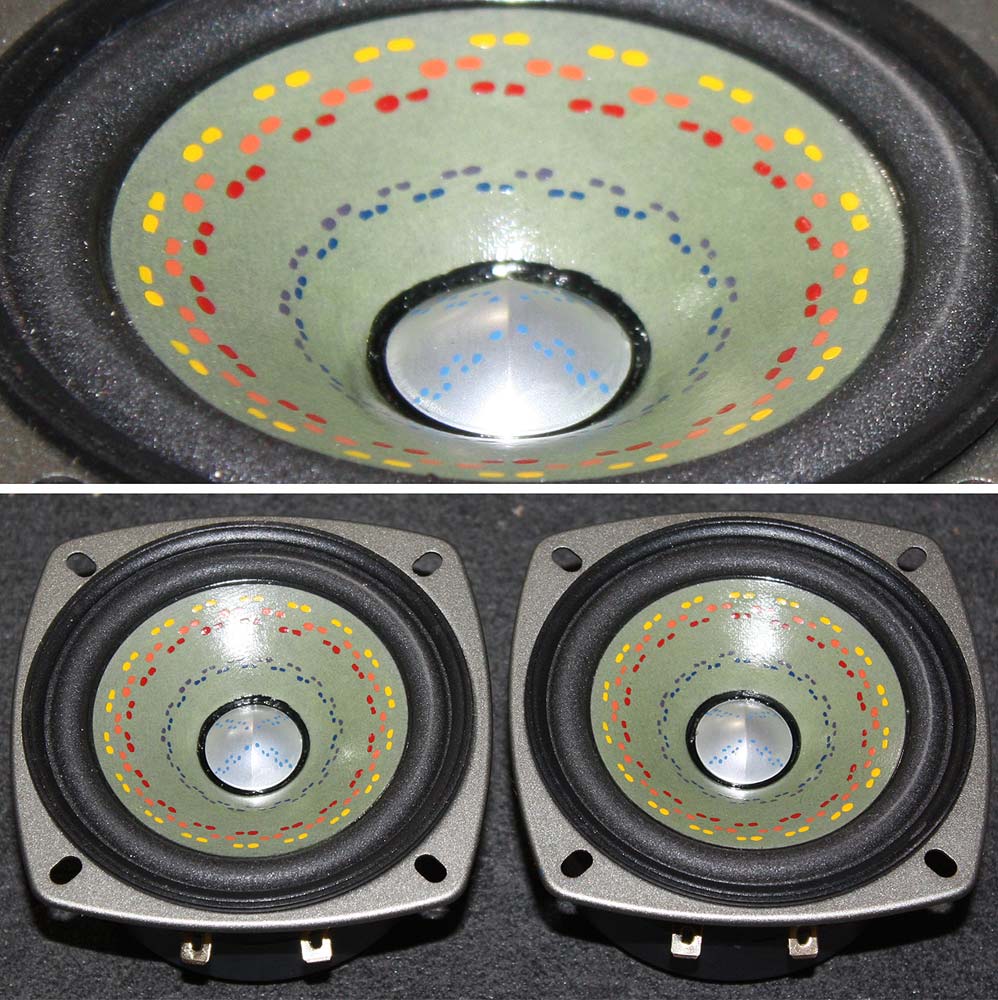p.s. are the other waterfalls EnABL vs control or two EnABL samples?
Control + EnABL.
dave
to compare is: untreated cone vs cone treated with EnABL dots only! Not untreated cone vs cone treated with WetLook/ModPodge plus EnABL dots!
Exactly what was done. I had nothing to do with these tests, drivers were EnABLed byn Bud.
ModPodge is an extra step i take with paper cones. Metal cones only getb EnABL.
dave
principle of operation of EnABL
No-one really knows how it works. The technique has also evolvbed since the patent.
dave
I was comparing physics of dimples applied to airplane and a golf ball. Your example is something very different.As you know the speaker cone vibrates up to 20,000 "CPS" as hundreds of large beads (up to 1/10 relative to wavelength) grab a "load" of air.
Who can say what might happen at the scale of very high frequency sound.
As for the cone vibrating at 20,000 cps etc, it is no wonder who can say what might happen - it is audio/acoustic science, which answered that question already. It is in the books.
The inventor claims he knows how it "works" - it is described in the patent.No-one really knows how it works.
I can't see any evolution - EnABL dots are the same as in the patent.The technique has also evolved since the patent.
Last edited:
There are 21 measurements. Which measurements are for the metal cone only (untreated vs treated)?Exactly what was done. ...
ModPodge is an extra step i take with paper cones. Metal cones only getb EnABL.
Link to the original source will be appreciated.
’The inventor claims he knows how it "works" - it is described in the patent.
But the patent author has said afterwards heis still only guessing (educated).
’’I can't see any evolution - EnABL dots are the same as in the patent.
As in the patent:

EnABL v2

I wanted pictures of metal cones… note that the rings are right at the surround and dustcap on Gen1. Fixed in place on any driver. Gen2 uses a tap test on the cone to find ideal ring placement.
Out of interest, on the Markaduio, it turns out the updated ringsets fall at the same point on the cone as the transition of the cone profile moves from 1 radius to the next. One uses a tap test to figure out where. Listen to the cone as you tap it, where you hear a change in tone place a rignset there.
I have also used the tap test to find the unique pattern that quells some ringing in FFxx5wk metal dustcaps.


The extra ring at the surround helps with a surround/con termination issue, as does the ZIG on the back.
dave
So - he was lying in the patent. As expected...But the patent author has said afterwards heis still only guessing (educated).
As in the patent:
Still can't see any difference - dots are the same.EnABL v2
Last edited:
It is a patent … who cares, it is like 3 decades since that was granted. Much has been learned since then.
And Bud has freely shared his technique and has been very helpful.
dave
And Bud has freely shared his technique and has been very helpful.
dave
We are not going anywhere with this... OK, lets go on something more productive. I will repeat my request:
Please?There are 21 measurements. Which measurements are for the metal cone only (untreated vs treated)?
Link to the original source will be appreciated.
Last edited:
Please
You’d have to ask Bud or those that did the tests. Even if they were paper cones, Bud did nthing more than EnABL.
dave
Can someone explain to me what is EnABL??
From searching this website & some of Dave's links, I gather it is the use of rings of magic dots on speaker cones. This will certainly change the breakup behaviour of the cone the sound. But I'm not sure Daves's 'waterfalls' are evidence of 'improved' sound.
From searching this website & some of Dave's links, I gather it is the use of rings of magic dots on speaker cones. This will certainly change the breakup behaviour of the cone the sound. But I'm not sure Daves's 'waterfalls' are evidence of 'improved' sound.
If you add mass, something will change for sure.
Its possible we hear changes long before we can measure them.
However, its hard to predict if the change is possitive. If the speaker maker made cone very light on purpose as to obtain certain acceleration, adding mass may cure some breakups, but on the other hand remove some speed. Too much mass and fullrange becomes woofer.
Its possible we hear changes long before we can measure them.
However, its hard to predict if the change is possitive. If the speaker maker made cone very light on purpose as to obtain certain acceleration, adding mass may cure some breakups, but on the other hand remove some speed. Too much mass and fullrange becomes woofer.
I was comparing physics of dimples applied to airplane and a golf ball. Your example is something very different.
As for the cone vibrating at 20,000 cps etc, it is no wonder who can say what might happen - it is audio/acoustic science, which answered that question already. It is in the books.
I'm not sure the controlled use of cone breakup for high frequency output, pioneered by Ted Jordan, is "in the books" in the sense of a diy-accessible textbook (or even fully published). Exemplified by his JX92S (which I have) flat amplitude and phase truly "fullrange", used and tested by Jim Griffin RIP.
View (preferably in 3D) the second link among the "data" with blue and red (once tapped) waterfalls, source JohnK. Of course not knowing the test signal and conditions one has to make guesses while trying to interpret the data.
what is EnABL?
The original thread had to be slipt into 2 to keep the bickering down
This thread is a continuation of the EnABL Processes Thread here:
http://www.diyaudio.com/forums/showthread.php?s=&threadid=100399&perpage=25&pagenumber=1
This thread is for the objective side of things. If you wish to post your listening impression, please post them here:
http://www.diyaudio.com/forums/showthread.php?s=&threadid=119676
http://www.diyaudio.com/forums/showthread.php?s=&threadid=100399&perpage=25&pagenumber=1
This thread is for the objective side of things. If you wish to post your listening impression, please post them here:
http://www.diyaudio.com/forums/showthread.php?s=&threadid=119676
- Cal Weldon
- Replies: 1,476
- Forum: Multi-Way
This thread is a continuation of the EnABL Processes thread here:
http://www.diyaudio.com/forums/showthread.php?s=&threadid=100399&perpage=25&pagenumber=1
This thread is for listening impressions and questions concerning applications. This is not to contain the technical side of things. Those posts will be deleted. The thread for that is here:
http://www.diyaudio.com/forums/showthread.php?s=&postid=1460032#post1460032
http://www.diyaudio.com/forums/showthread.php?s=&threadid=100399&perpage=25&pagenumber=1
This thread is for listening impressions and questions concerning applications. This is not to contain the technical side of things. Those posts will be deleted. The thread for that is here:
http://www.diyaudio.com/forums/showthread.php?s=&postid=1460032#post1460032
- Cal Weldon
- Replies: 1,209
- Forum: Multi-Way
3 postsbstarting here describe the technique (posts bby Bud Purvine coopied from another forum):
Tutourial #1 -- Materials
3 posts by Bud copied from the Hawthorne forum:
Materials:
The block paint I use comes from Polly S corporation, a division of Floquil / Testors. Any of their flat paints will do. But, if you do not want to stare at this lacy pattern every time you listen to music, use the flat clear paint. This is a bit more difficult to use, and I will cover what and why a bit later. Quite a wide variety of substitute materials have been tried successfully, by other people.
Next is Micro Scale micro gloss coating. Please do not substitute other materials for this...
3 posts by Bud copied from the Hawthorne forum:
Materials:
The block paint I use comes from Polly S corporation, a division of Floquil / Testors. Any of their flat paints will do. But, if you do not want to stare at this lacy pattern every time you listen to music, use the flat clear paint. This is a bit more difficult to use, and I will cover what and why a bit later. Quite a wide variety of substitute materials have been tried successfully, by other people.
Next is Micro Scale micro gloss coating. Please do not substitute other materials for this...
Preceding post has a bunchof examples,
And the later introduction of the “tap test” to find out where to best place the ringsets. This is whatbmakes EnABL 1 different than EnABL2.
The AN 8 patterns will show you where on the AN 12 to concentrate, using them directly would be a mistake. We are now deeply into correcting specific emission irregularities. Until more data, meaning more drivers, have been corrected we must do this in an imprirical fashion. Called the "tap test" for soon to be obvious reasons.
When you recieve Ed's kit, you will have one of the most useful tools possible for this activity, the pen tip holder, the long black wooden one. If you grasp it lightly between fingers and thumb, on the large diameter end, you can use the tip to lightly tap the...
When you recieve Ed's kit, you will have one of the most useful tools possible for this activity, the pen tip holder, the long black wooden one. If you grasp it lightly between fingers and thumb, on the large diameter end, you can use the tip to lightly tap the...
dave
EnABL is pure snake oil, applied to speaker cones (and enclosures!) as dots. Those dots are drawn by fine tip acrylic marker.Can someone explain to me what is EnABL??
It will not change anything, because mass and surface area of the painted dots are insignificant compared to the cone mass and area, and especially to the mass of the enclosure. For example, MAOP 7 has 3.9 g mass, Alpair 10 P has 5.2 g mass, Pluvia 11 has 11.4 g mass.From searching this website & some of Dave's links, I gather it is the use of rings of magic dots on speaker cones. This will certainly change the breakup behaviour of the cone the sound.
Confirmed by measurements are improvements done by applying ModPodge or WetLook in large continuous rings (or large stripes), or across of the whole cone area, in 3 layers - that mass and effect of changing cone resonance behavior is far greater than those silly dots.
Last edited:
If you're convinced it's snake oil, then please stop posting in this thread.EnABL is pure snake oil, applied to speaker cones (and enclosures!) as dots.
jeff
According to the Rules of DiyAudio it is allowed to criticize something in every possible thread.If you're convinced it's snake oil, then please stop posting in this thread.
So, what do you think about this part of the EnABL patent:
Magic EnABL dots (marked with 69 on 8B) on the loudspeaker enclosure - do they have any impact on the sound? According to the EnABL inventor - yes. And according to you?
are drawn by fine tip acrylic marker.
With a caligraphy pen and model train paint. Creates a bump you can feel.
dave
Let me contribute two methods I use to compare directly two slightly different drivers/XO. One I've mentioned before, repeat same music segment but swapping very quickly L/R inputs to the amp; compare the left and right half-soundstage for clarity and dynamics. Another is to separate the speakers about 1m just slightly toed in, and listen from 3m, so a turn of the head toward one side say the left, aligns right ear to be on-axis with R speaker but (ear) angled 20-30° for max-acuity, simultaneously reducing the left ear and L speaker to min-acuity; listen back and forth to compare transcient detail and sense of depth beyond the speaker. (I guess alternately covering one ear would do too, set up in equilateral listening position.)
Of course the listening environment should be symmetric and well-damped etc., and left/right ear hearing controlled for differences.
Of course the listening environment should be symmetric and well-damped etc., and left/right ear hearing controlled for differences.
Last edited:
- Home
- Loudspeakers
- Full Range
- EnABL-ing MAOP7